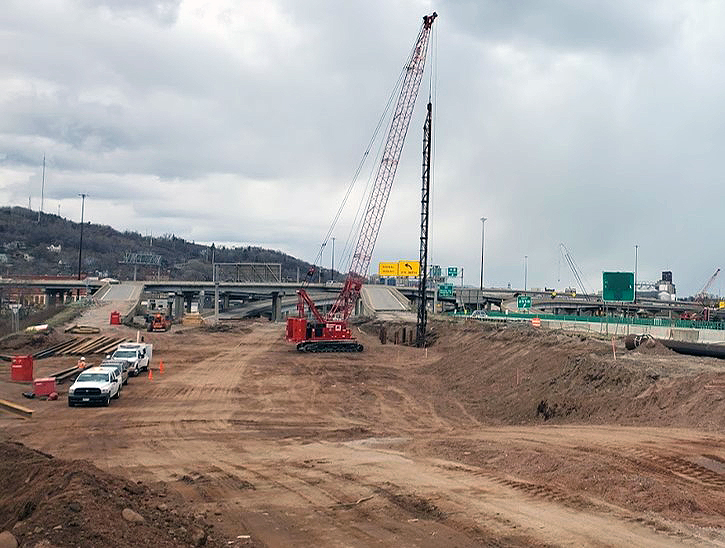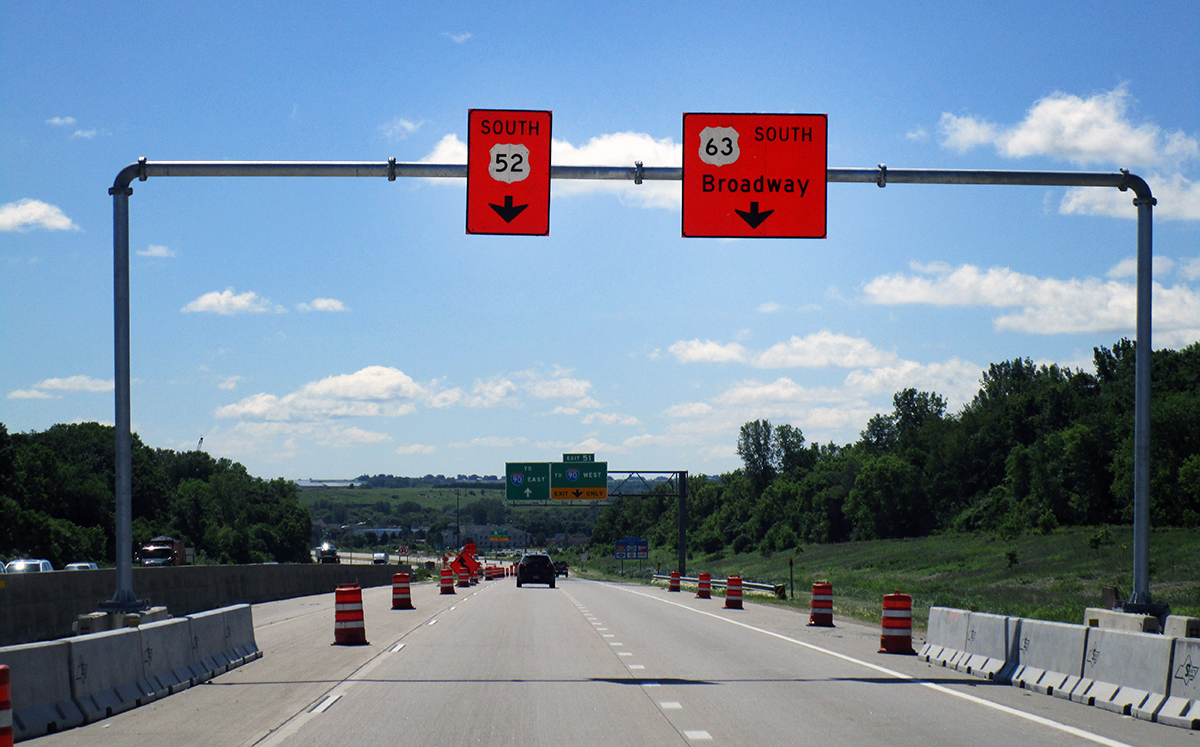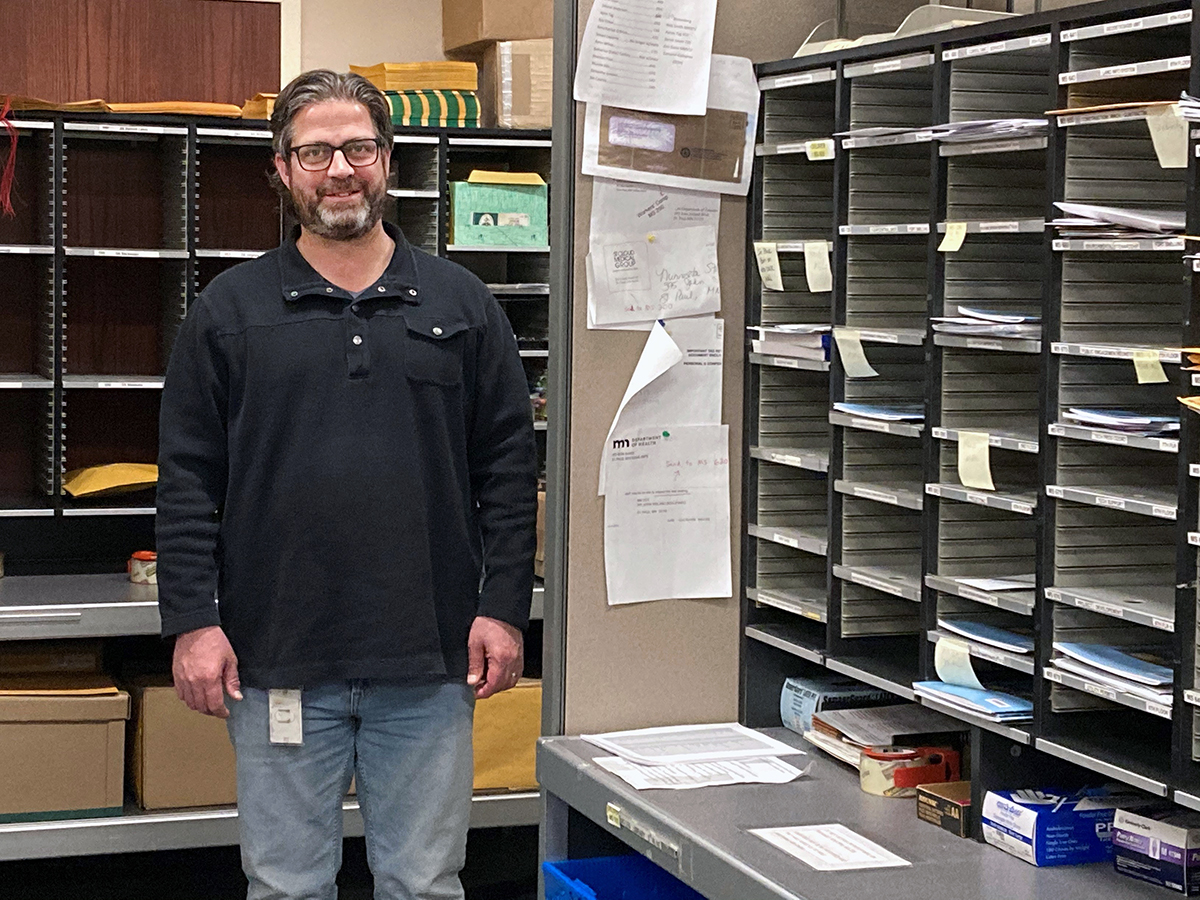 |
|

|
 |
TABLE of CONTENTS
 |
AASHTO video highlights MnDOT’s sustainability, environmental stewardship efforts |
The American Association of State Highway and Transportation Officials featured MnDOT’s sustainable transportation and environmental stewardship efforts last week in a video marking Earth Day 2021.
Commissioner Margaret Anderson Kelliher, who chairs AASHTO’s Committee on Environment and Sustainability, was interviewed for the seven-minute video and described how sustainability, as a practice, has become a core function within state departments of transportation across the country over the past 25 years.
She said, for example, that MnDOT elevated its sustainability and public health function to a division level because it puts the assistant commissioner [Tim Sexton, who is also the chief sustainability officer] at the same table as engineering, maintenance and operations.
“So, things are more of a discussion and we are not trying to insert this topic of sustainability and public health from the side or from below,” she said. “It's at an equal level to the other divisions in MnDOT…so it's really integrated into the work instead of being separate from the work.”
The commissioner noted the variety of work the Office of Environmental Stewardship performs that also contributes to a healthy environment and sustainable transportation system. Among other things, their responsibilities include ensuring that regulations under the National Environmental Policy Act are being followed at MnDOT construction sites; protecting historical buildings, graveyards and tribal areas; and working with local communities on the visual quality of state highways to ensure projects fit into the environment as much as possible.
For more information:
| |
|

|
 |
TABLE of CONTENTS
 |
MnDOT remembers fallen, injured workers on Worker Memorial Day |

The I-35W bridge, lit orange in honor of Worker Memorial Day. MnDOT file photo |
By Anne Meyer
Every April 28, MnDOT’s “Worker Memorial Day” honors those injured or killed while working on Minnesota highways.
Since 1960, 35 MnDOT employees and 16 private sector contractors have been killed on the job.
This number increased by one recently. With the family’s permission, Vern Hedquist’s name was added to the Worker Memorial list this year. Hedquist was hit and killed in 2018 while working as a contractor in a work zone on Interstate 94 near Rogers. Prior to his work at WSB, Hedquist worked for MnDOT for more than 20 years.
Gov. Tim Walz proclaimed April 28 as “Worker Memorial Day in Minnesota” to recognize these fallen and injured workers. The I-35W Bridge in Minneapolis will also be lit orange on April 28 to honor them.
District 6 hosted a virtual event to honor fallen workers. Commissioner Margaret Anderson Kelliher spoke, as did members of the Minnesota State Patrol, city of Rochester and labor unions.
Visit MnDOT’s Worker Memorial website to learn more about each fallen worker.
| |
|

|
 |
TABLE of CONTENTS
 |
Duluth digs into Can of Worms |
By Pippi Mayfield, District 1 Public Engagement and Communications

Work has begun on the Twin Ports Interchange project in Duluth. Pavement on southbound I-35 has been removed and work is being done on the Miller Creek and Coffee Creek relocation portion of the project. Photo by Byron Amo |
It seems that no matter how much preparation is done for a major project, the impact isn’t truly realized until the orange cones go up.
In early April, lanes closed on the Interstate 35 Twin Ports Interchange project (better known as “the Can of Worms”) through Duluth. Throughout the remainder of the summer, interstate traffic is one lane in each direction, and several ramps are now closed for the duration of the project.
The three overall goals of the TPI project are to:
- Enhance safety by eliminating blind merges and left exits
- Replace aging infrastructure
- Better accommodate freight movement coming to/from the Duluth-Superior port
Initially, in addition to the work along I-35, District 1 planned to replace the Garfield Avenue/I-535 interchange and Hwy 53 bridge at the same time. Due to a funding gap, those two portions of the project were deferred.
Work first began on the TPI project in October 2020, with the demolition of the 27th Avenue West bridge, which was then under construction throughout the winter. Crews should complete this by mid-June. Work started on the Miller Creek and Coffee Creek relocation portion of the project in April, and several ramps were closed.
“We have definitely dived into some of our earthwork and utility work in good earnest,” said Pete Marthaler, District 1 construction manager.
Four lanes will open up to interstate traffic this fall: northbound on the actual interstate and southbound on Lower Michigan Street, which will be barricaded off from the Lincoln Park neighborhood for safety purposes. The project is scheduled to finish in 2024.
Two time-lapse cameras are capturing work on the project. The link for these cameras, along with more information, can be found on the project webpage.
|
 |
|

|
 |
TABLE of CONTENTS
 |
Temporary overhead signs direct drivers through work zones |
By Joseph Palmersheim

This temporary overhead sign installation is owned by MnDOT and stored in District 6. It has been used in work zones in the district and in the Twin Cities metro each year since 2016. MnDOT file photo |
A recently developed device in MnDOT’s tool kit has its roots in a problem District 6 engineers faced during a Hwy 52 project in 2016.
The project needed a clear, visible means to direct traffic through the work zone. District staff determined that overhead signs with “down arrows” would be easier to understand than ground-mounted signs with lengthy messages in the median and off the right shoulder.
But such a thing didn’t exist at the time.
In response, the Office of Traffic Engineering and Bridge Office designed a structure capable of spanning over up to four lanes of traffic, with footings on the shoulder. This allows sign panels to be centered above the lanes. The structure is made of readily available parts, like tube sections, steel plates, bolts and barrier sections.
Crews can assemble the structure alongside the highway and lift it into place with a crane. The design of the temporary overhead sign structure uses portable concrete barrier sections as a base placed on the roadway or temporary gravel pad.
“The design of the temporary overhead sign structure is a balance of enough of a structure to place signs overhead and a system that can be installed temporarily and be reusable,” said Michelle Moser, work zone engineer. “They are a temporary version of the sign bridges we have for permanent signs. Until now, we did not have a structure that could be used in the work zone for overhead signing where we do not have a bridge overpass to place signs on. Work zone signs are generally ground mounted or on portable stands, which may be hard to see outside of the work area or when obscured by equipment.”
The original structure, owned by MnDOT and stored in District 6, has been used in work zones in the district and in the Twin Cities metro each year since 2016.
Staff developed a standard design, and are working with industry and project personnel to deploy these temporary overhead signs on more of MnDOT’s projects statewide, Moser said.
“This is a great example of the problem-solving engineers do here to improve safety and mobility for the travelling public,” Moser said. “There was a specific problem that needed to be addressed, and through collaboration, we were able to make it happen. Great documentation of the details and lessons learned allowed us to fine-tune the design and come up with a standard that can be fabricated and used on other projects both in our state and beyond.”
|
| |
|

|
 |
TABLE of CONTENTS
 |
Take Your Child to Work Day: ‘I think my dad works at MnDOT because he loves it’ |
By Joseph Palmersheim
With some parents not technically taking themselves to work this year, MnDOT’s annual “Take Your Child to Work Day” looked a little different in 2021 than in years past.
Instead of skipping the event completely, though, employees asked the children in their lives what they think the adult’s day is like at MnDOT. Their responses came in the form of drawings, essays and videos. MnDOT’s Video Services Unit captured some of their responses in this video.
“Showing children a wide spectrum of career fields is so important in helping them get a glimpse of the types of careers options the world has to offer,” said Marcia Lochner, STEM Education and Outreach Program manager. “Take Your Child to Work Day is a great opportunity for employees to show children what they and their coworkers do at MnDOT.”
Some children wrote essays or drew pictures.
“My dad inspects bridges and highways out in the field in the summer,” one child wrote. “I think my dad works for MnDOT because he loves it and gets to be outside. I think my dad does his job by making sure contractors do the right thing. My dad works long hours in the summer so we have to go on vacation in the winter. In the fall, winter, and spring I think my Dad prepares for the upcoming projects and makes sure MnDOT pays the right amount of money. He works in the office during this time or at home during this COVID season. I know my dad works very hard and I hope I get to go to work with him one day.”
The more that children learn about what the adults in their lives do, the bigger their world of opportunities grows, Lochner said.
“Events like these are vital in recruiting a talented and diverse workforce in a very competitive market,” she said. “The earlier we reach children to spark their interest in the many career fields MnDOT has to offer and how they may align with specific interests, education and skillsets, the more successful we will be at recruiting them in the future. MnDOT employees hold the key to opening this world up for them and making a positive life-changing impact on any given child’s future.”
Do you know any teacher or parents looking for information on specific MnDOT career areas? Let them know about mndot.gov/stem, where they can request a virtual visit and find free educational activities and resources.
| |

|
 |
TABLE of CONTENTS
 |
Annual electronic storage cleanup starts May 5 |
By Charles Stech, Office of Chief Counsel
It’s time for spring cleaning.
MnDOT’s Annual Electronic Storage Cleanup starts Monday, May 5, and ends Friday, June 5. The office or district that reduces its shared drive storage the most will earn the Golden Hard Drive award. While organizers will measure progress every week, what counts is the overall percentage data reduction by June 5.
The agency is charged by the gigabyte per month of usage on all of the shared drives, like N, P or any other letter. Each terabyte is equal to 1,000 gigabytes. At 24 cents a gigabyte, one terabyte of storage space can cost $2,880 a year.
The MnDOT records retention schedule sets rules for how long records must be kept and what happens at the end of their lifecycle.
A record is information that documents MnDOT business decisions or transactions and is designated in the agency's retention schedule. It can take any format: electronic data, paper or even physical artifacts. Copies, drafts and meeting agendas are not records.
Steps employees need to take:
- District engineers and office directors will schedule four hours for their business areas to review electronic files between Monday, May 3, and Friday, June 5. During this time, all employees will:
- Review all electronic documents to determine whether they are records.
- Delete all outdated non-records from their shared drive.
- Delete or dispose of records that have reached the end of their retention period (refer to the retention schedule).
- Move all records to their designated storage location (shared drive, eDOCS, ProjectWise, etc.). Do not store non-business related personal files or data on MnDOT resources.
- Record clean-up activities on timesheets as:
- Project ID - T0008102
- Activity Code/Source Type – 0023
- Fill out a Records Destruction Report listing all records deleted. State government agencies are required by law to permanently retain a list of destroyed records. Non-records do not require a Records Destruction Report.
Storage levels will be posted on the Information Governance Program SharePoint, and the winners will be announced in June.
Previous award winners include:
- Office of Transit and Active Transportation – fall 2020
- Research and Innovation Office - fall 2019
- District 6 - spring 2019
- Office of Transit and Active Transportation - winter 2018
- Office of Civil Rights - spring 2018
Contact Charles Stech with questions.
|
| |
|

|
|

|
|

|
 |
TABLE of CONTENTS
 |
On the Job: Joe Silver and team keep Central Office mail center running smoothly |
By Joseph Palmersheim

Joe Silver. Photo by Anne Meyer |
Joe Silver oversees MnDOT’s mail center at Central Office. Silver, an office services supervisor, worked in mail centers at both the Department of Natural Resources and Department of Health before coming to MnDOT in 2015.
His team in the mail center helps process more than 400 pieces of mail each day. The volume has decreased slightly during COVID, he estimates.
What kind of impact has COVID had on your normal day-to-day?
We have made a few changes due to COVID. The amount of emails and phone communication we have with employees has increased regarding incoming packages and coordinating the handoff. We worked with offices on how they would like us to handle their daily incoming and any outgoing USPS mail, inter-office mail and packages coming in from couriers. We have also incorporated curbside pickup and delivery as an option.
How have people been getting their mail?
Some offices have asked us to continue to do what we did before COVID, when mail center staff would deliver and pickup at designated locations at 10 a.m. and 2 p.m. daily, and a designated employee would take care of it. Some offices have asked us to hold their mail in the mail center, and an employee will come into the mail center and pick it up.
What is it like to work in a nearly empty building that used to be so busy?
I actually come into the office one to two times a week, teleworking the other days. When I am in the office, it is very quiet. When I would walk in the building before COVID, there was already business going on, people coming and going to meetings, people coming and going from the cafeteria and random conversations amongst people, lots of energy. Work areas once lit and full of energy are now empty and dark, at least until the lights recognize a person and then they turn on.
How do you think you’ll look back on this time when all is said and done?
I think I will look back and think about how so many people adapted to something that was so unexpected. It was an exercise in figuring out, ‘Can work and tasks be done remotely, and what will that look like?’
I am so proud of my staff. They are in the building every day. They did so well in adapting to new ways we needed to do business, with more communication among each other and other offices. They are in the building every day during the week. They have done an exceptional job adapting and navigating the changes, upping the amount of emails and phone communication that has come along with so many people being out of the office. Without them, it could and would have been much, much tougher getting the job done and done well.
Do you or a co-worker have an interesting job to share with readers? Send us your ideas, and we’ll contact you for more information.
Recent employee profiles:
|
| |
|
| |
|



